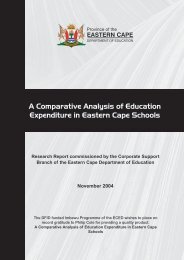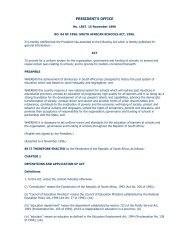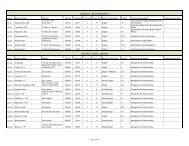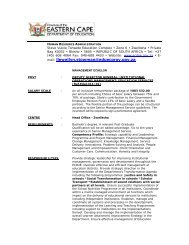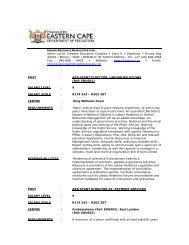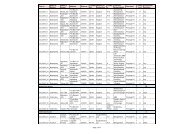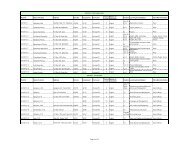part a: strategic overview - Department of Education
part a: strategic overview - Department of Education
part a: strategic overview - Department of Education
You also want an ePaper? Increase the reach of your titles
YUMPU automatically turns print PDFs into web optimized ePapers that Google loves.
When comparing the school-age population (Graph 5:7-18 age group) with the actual<br />
learner enrolment recorded in the Annual Survey, a pattern emerges for the period 1995<br />
to 2001 that was reversed in 2002. School enrolment for the seven-year period 1995 to<br />
2001 was consistently higher than the equivalent school-aged population. This normally<br />
indicates that a proportion <strong>of</strong> the learner enrolment is either over-aged or under-aged<br />
and probably both. In 2002 however, the reported enrolment in the Annual Survey was<br />
slightly below the total population aged 7 to 18. This will be investigated further in the<br />
section dealing with indicators.<br />
Graph 5: School Age Population Aged 7-10 Years compared with reported Learner Enrolment for<br />
the Period 1995-2002<br />
2500000<br />
2000000<br />
1500000<br />
1000000<br />
500000<br />
0<br />
1995 1996 1997 1998 1999 2000 2001 2002<br />
School Age Population Learner Enrolment<br />
13.4 Socio-economic Deprivation in Eastern Cape Communities<br />
Since communities play a vital <strong>part</strong> in supporting the provision <strong>of</strong> education, it is<br />
important to review the socio-economic environment in which those communities exist.<br />
In order to undertake a comparison, a socio-economic deprivation index has been<br />
calculated for education districts by combining various social and economic criteria from<br />
the 2001 Census.<br />
The following criteria were used to create the index:<br />
� Functional Literacy - percentage <strong>of</strong> the adult population that has attained at least<br />
Grade 6 schooling, divided by the total number <strong>of</strong> adults (age 20 and above) See<br />
Map 4 on page 80.<br />
� Per Capita Income - total annual income divided by the total population<br />
� Percentage <strong>of</strong> households with electricity (supplied by Eskom or a local municipality)<br />
Each criterion was ranked from worst to best, given equal weight and combined into a<br />
single standardized index ranging from 1 (most poor) to 0 (least poor). It is important to<br />
note that the score measures relative rather than absolute disadvantage within the<br />
Eastern Cape, and compares the performance <strong>of</strong> districts to one another and not to a<br />
defined national benchmark.<br />
<strong>Education</strong> districts with the highest score, or those identified to be the most<br />
disadvantaged in terms <strong>of</strong> the criteria used, are typically characterized by:<br />
� High unemployment<br />
5 Year ECDoE Strategic Plan for 2005/06 to 2009/10. March 2006 Page 68<br />
5 Year ECDoE Strategic Plan for 2005-06 to 2009-10. 21 F (4) Page 64<br />
<strong>part</strong> C: background information




